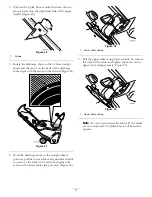
Storage
Storing the Snowthrower
•
Gasoline fumes are highly flammable,
explosive, and dangerous if inhaled. If you
store the product in an area with an open
flame, the gasoline fumes may ignite and
cause an explosion.
•
Do not store the snowthrower in a house
(living area), basement, or any other area
where ignition sources may be present,
such as hot water and space heaters, clothes
dryers, furnaces, and other like appliances.
1. On the last refueling of the year, add fuel stabilizer
to fresh fuel as directed by the engine manufacturer.
2. Run the engine for 10 minutes to distribute the
conditioned fuel through the fuel system.
3. Stop the engine, allow it to cool, and siphon the fuel
tank or run the engine until it stops.
4. Start the engine and run it until it stops.
5. Choke or prime the engine, start it a third time, and
run the engine until it will not start.
6. Dispose of unused fuel properly. Recycle it according
to local codes, or use it in your automobile.
Note:
Do not store stabilized gasoline for more
than 90 days.
7. While the engine is still warm, change the engine oil.
Refer to Changing the Engine Oil.
8. Remove the spark plug.
9. Squirt 2 teaspoons of oil into the spark plug hole.
10. Install the spark plug by hand and then tighten it
securely. If you do not have a torque wrench, tighten
the plug firmly.
11. With the ignition key in the Off position, pull the
recoil starter slowly to distribute the oil on the inside
of the cylinder.
12. Clean the snowthrower.
13. Touch up chipped surfaces with paint available
from an Authorized Service Dealer. Sand affected
areas before painting, and use a rust preventative to
prevent the metal parts from rusting.
14. Tighten any loose fasteners. Repair or replace any
damaged parts.
15. Cover the snowthrower and store it in a clean, dry
place out of the reach of children. Allow the engine
to cool before storing it in any enclosure.
18



































